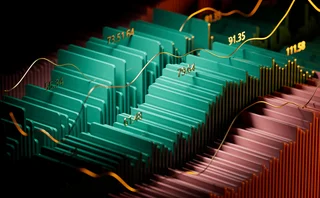Waters Wrap: Examining ASX’s CHESS do-over
The Australian exchange was the first exchange to be all-in on DLT—and the project failed. Anthony speaks with ASX’s Tim Whiteley to discuss the lessons learned and why he thinks the second attempt will succeed.

I was surprised when word came out on November 20 that the Australian Securities Exchange had selected Tata Consulting Services to run its CHESS replacement project.
Yes, TCS is a big, well-respected company; it has a product that’s in use at other global exchanges; and it has a significant presence in Australia. It’s not necessarily the company itself that stands out. Certainly, ASX choosing Digital Asset in 2017 for the (now failed) first replacement project was much more surprising.
No, it caught me off guard because my money would’ve been on one of the big cloud providers or a white-labeled product from a large exchange. Specifically, I’d have bet the house on the choice of Google or Nasdaq.
Some context: As I’ve written before (here, here, here and here, just to link to a few of many), cloud—not blockchain—is the exchange technology of the future. (Well, it’s rapidly becoming the tech of today.) CME, LSEG, Nasdaq and Deutsche Börse have all inked high-profile deals with Amazon, Google or Microsoft to modernize their trading infrastructures. ASX, following the growing herd of major exchanges teaming with Big Tech made sense. Furthermore, ASX signed a deal last year with Google as its preferred cloud partner to improve its analytics capabilities.
If ASX had decided against a Big Tech partnership, the next logical choice (to me, anyway) was Nasdaq, as ASX uses its white-labeled exchange matching engine and risk tools. Why not extend that relationship? (For clarification: I do not know which companies were involved in the selection process; those companies above are based on industry rumors and my own intuition.)
Even though it was a very painful experience, we’re pretty well set up for this phase.
Tim Whiteley, ASX
To better understand ASX’s thinking for the project, I spoke with Tim Whiteley. First, his bona fides: He was named the exchange’s chief information officer this summer after joining in November 2022, where he was tasked with leading the CHESS project after the exchange decided to part ways with Digital Asset. He has more than 25 years of experience and has served in various executive roles at major Aussie banks, Westpac and Commonwealth Bank.
He says that the reason why TCS won comes down to risk mitigation concerns. Back in the mid-2010s, as ASX began to look at ways to address its aging system—CHESS standing for Clearing House Electronic Subregister System, its clearing and settlement platform—blockchain technology was rapidly climbing up the Gartner Hype Cycle. It was a controversial decision to go with DLT (which I’ll use interchangeably with blockchain) because it had yet to be proven if it could handle the volume and market structure complexities of a major securities marketplace.
Whiteley—who was not involved in the original selection process—says that the off-the-shelf options were not up to snuff back then. In the years since, that’s changed.
“I think when ASX looked at what their options were, most all of the products were well behind how the Australian market operated,” he says. “And so we were pleasantly surprised with the level of progress that more than one vendor had made.”
TCS, in particular, has a tried-and-tested product—Bancs (well, BaNCS, but no). TCS’s work with Euroclear Finland and Canada’s TMX Group, among others, was most pertinent to ASX, though.
For example, Australia uses a “name on register” model, which serves as the official record of a company’s shareholders and is regularly updated to reflect changes in ownership through share transactions. It serves as the backbone for things like dividend distribution, corporate actions, and determining voting rights. Whiteley says that TCS had recently developed functionality for the model in partnership with the Finnish marketplace. Additionally, as Australia contemplates a move to T+1, TMX is currently working with its members as North America will move from T+2 to T+1 next year. So ASX can learn lessons from TMX and modify its iteration of the TCS platform.
A new world
Like the first replacement selection process, ASX could’ve tried to upgrade CHESS internally; build something new from scratch; partner with a vendor to create something new (i.e., Digital Asset’s DLT); or buy something off the shelf. ASX went with that last option (what they call “a product-based solution”).
What TCS allows for is (they hope) minimal customization. Bancs, a licensed software platform, is as close to out-of-the-box as it comes—TCS’s work with Finland and Canada (and South Africa and New Zealand) can be carried over to the CHESS replacement. “There’s actually a low level of customization in the core product,” Whiteley says.
Our challenge is that ASX is not quite big enough to become a software shop, as well as an exchange. So that led us to buy something that worked.
Tim Whiteley, ASX
Furthermore, he says the end solution will be interoperable with third-party systems. This is important because Australia enacted legislation to foster competition in post-trade clearing and settlement within financial markets, with ASX being described as a near-monopoly.
“The interoperability supports the fact that competitors could come and provide another clearing service on top of the settlement and subregister and the like. Or, they could even have another settlement service on top of the sub-register,” he says. “So that’s why interoperability is a big word in this announcement.”
I’ve had two people tell me that they believed ASX chose TCS simply because of cost—essentially, the exchange had to take an AUS$245-255 million (~$165-170m) pre-tax write-off as a result of pulling the plug on the original project, industry participants were pissed, and so cost became the main driving factor. It’s a bit cynical, but that’s certainly not out of the realm of possibility.
Whiteley says that is an incorrect reading of the situation. A quick Q&A:
WatersTechnology: What would you say to people who think that TCS wasn’t the best technology, but the best choice for the cost? (That’s not exactly how I worded it, but the actual question might’ve gone on for five minutes.)
Whiteley: Almost all the options start at about the same cost. Basically, due to the time it takes for the industry to be ready, to prepare their code, and to provide the time to set things up, all projects go for four-ish years. So that’s what drives the cost—the time, not the actual software. All the software is probably the same cost.
…The actual starting cost was not a differentiator at all. Those other products you mentioned before [Amazon, Google, Microsoft, Nasdaq, LSEG] would’ve been the same cost. Something like choosing Google, for example, would’ve been the equivalent of us going and doing another blockchain just with another technology, because we would’ve had to build every business function and come up with a technology stack on Google. We would have to come up with the database we will use. We’d have to design a database structure, so we’d have to get another partner other than Google that is good at post-trade equities to come in and help us build all the business logic. So that part didn’t make any sense.
WatersTechnology: Still, it’s surprising that as the likes of CME, Deutsche Börse, LSEG and Nasdaq embrace the cloud, ASX seems to be taking a different path. (Again, this is not how it was worded, but you get the gist.)
Whiteley: In terms of leveraging cloud, we definitely aim to do that. We need to work with our regulator and see if we can run the actual application on the cloud. But we leverage cloud and Google and AWS within the ASX environment.
The issue is that they [the cloud providers] don’t have all the business logic. We were trying to buy an established business processing, clearing and settlement system—it’s 400 messages, so it’s a complex set of business logic, database, etcetera.
…Our challenge is that ASX is not quite big enough to become a software shop, as well as an exchange. So that led us to buy something that worked.
From there, we assessed all of the products. TCS was the one that best fit our requirements. We also have relationships with other providers, like Nasdaq, which provides our trading systems.
Also, in Australia, how do we get good support? They have a big onshore support model with about 8,000 people here, so they’re used to operating in Australia. And the India time zone is good for us as well.
The blockchain in the room
Since I thoroughly enjoy expressing my disdain for blockchain (for things outside the world of crypto/digital assets/tokenization…pick your word), I had to ask Whiteley about his thoughts.
“I would think that we proved that you couldn’t use DLT for the more traditional style of processes that exist in a back office,” he says. “I think that was clear from the Accenture report (PDF). If you look at the main issues, we were trying to do the clearing and settlement batch-style processing. We needed to get very quick trade registration, and they’re not features that naturally come in a DLT solution. …They [DLT solutions] have a place, but not in the traditional processing model that exists in clearing and settlements, just by nature of the style of workload.”
Several times, Whiteley noted that the new CHESS would be interoperable with outside DLT solutions (and “other innovations”). But in this instance, it wasn’t the post-trade revolution that many had promised.
That said, Whiteley believes the exchange is much better positioned going into this CHESS re-platform redo. (To be fair, the sword of Damocles now hangs over his head, so I’d imagine that he would be more confident with this newest attempt.) But of note, the industry will have more time to prepare and put a team in place because the exchange learned from the last go-round that a staged, two-part approach is better than a big-bang release. And, again, the core product already exists and doesn’t need to be fully built from the ground up.
He also notes that while ASX “will not reuse any of the code” from the last project, there was a lot of work done around ISO messaging and FIX interfaces that will be carried over.
“The benefit we have going in is we’ve done a lot of work. We pretty much nearly got there. We had a strong set of requirements the industry had signed off on. … So we’re hoping that most of our lessons learned are covered by the fact that we’ve already been through it,” he says.
“Even though it was a very painful experience, we’re pretty well set up for this phase.”
The image accompanying this column is “The Ballet from ‘Robert le Diable’” by Edgar Degas, courtesy of The Met’s open-access program
Only users who have a paid subscription or are part of a corporate subscription are able to print or copy content.
To access these options, along with all other subscription benefits, please contact info@waterstechnology.com or view our subscription options here: http://subscriptions.waterstechnology.com/subscribe
You are currently unable to print this content. Please contact info@waterstechnology.com to find out more.
You are currently unable to copy this content. Please contact info@waterstechnology.com to find out more.
Copyright Infopro Digital Limited. All rights reserved.
As outlined in our terms and conditions, https://www.infopro-digital.com/terms-and-conditions/subscriptions/ (point 2.4), printing is limited to a single copy.
If you would like to purchase additional rights please email info@waterstechnology.com
Copyright Infopro Digital Limited. All rights reserved.
You may share this content using our article tools. As outlined in our terms and conditions, https://www.infopro-digital.com/terms-and-conditions/subscriptions/ (clause 2.4), an Authorised User may only make one copy of the materials for their own personal use. You must also comply with the restrictions in clause 2.5.
If you would like to purchase additional rights please email info@waterstechnology.com
More on Trading Tech
Recent volatility highlights tech’s vital role in fixed income pricing
MarketAxess’ Julien Alexandre discusses how cutting-edge technology is transforming pricing and execution in the fixed income market amid periodic bouts of volatility
Banks fret over vendor contracts as Dora deadline looms
Thousands of vendor contracts will need repapering to comply with EU’s new digital resilience rules
Where have all the exchange platform providers gone?
The IMD Wrap: Running an exchange is a profitable business. The margins on market data sales alone can be staggering. And since every exchange needs a reliable and efficient exchange technology stack, Max asks why more vendors aren’t diving into this space.
This Week: Trading Technologies completes ANS deal; State Street; Equinix; and more
A summary of the latest financial technology news.
Interactive Brokers looks beyond US borders for growth opportunities
As retail trading has grown in volume and importance, Interactive Brokers and others are expanding international offerings and marketing abroad.
JP Morgan’s goal of STP in loans materializes on Versana’s platform
The accomplishment highlights the budding digitization of private credit, though it’s still a long road ahead.
As data volumes explode, expect more outages
Waters Wrap: At least for those unprepared—though preparation is no easy task—says Anthony.
This Week: ICE Bonds and MarketAxess plan to connect liquidity networks, TS Imagine, Bloomberg, and more
A summary of the latest financial technology news.








